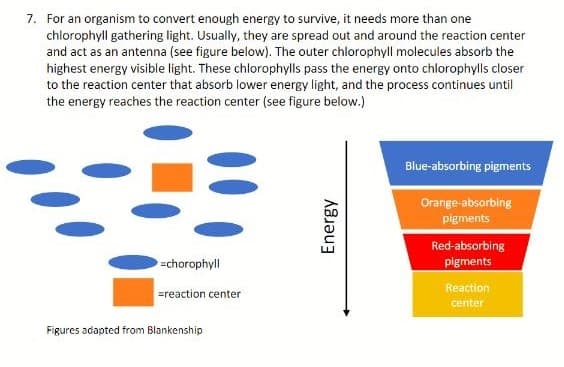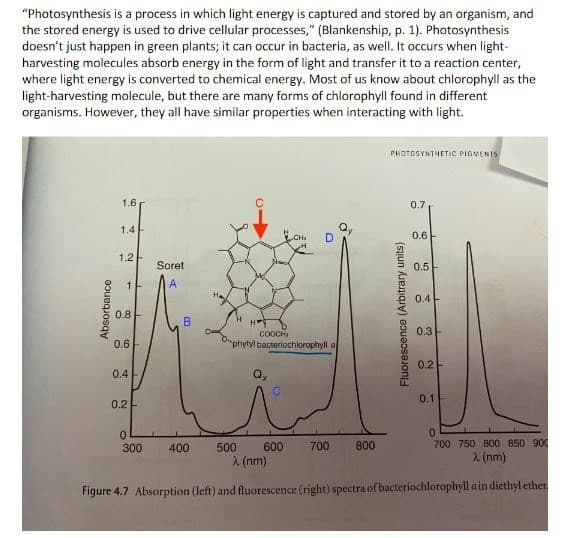As energy passes from blue-absorbing chlorophylls down to red-absorbing chlorophylls, surprisingly, no energy passes from lower energy-absorbing pigments back to higher ones (in other words, the process is irreversible). Why might that be?
As energy passes from blue-absorbing chlorophylls down to red-absorbing chlorophylls, surprisingly, no energy passes from lower energy-absorbing pigments back to higher ones (in other words, the process is irreversible). Why might that be?
Human Anatomy & Physiology (11th Edition)
11th Edition
ISBN:9780134580999
Author:Elaine N. Marieb, Katja N. Hoehn
Publisher:Elaine N. Marieb, Katja N. Hoehn
Chapter1: The Human Body: An Orientation
Section: Chapter Questions
Problem 1RQ: The correct sequence of levels forming the structural hierarchy is A. (a) organ, organ system,...
Related questions
Question
100%
As energy passes from blue-absorbing chlorophylls down to red-absorbing chlorophylls,
surprisingly, no energy passes from lower energy-absorbing pigments back to higher
ones (in other words, the process is irreversible). Why might that be?

Transcribed Image Text:7. For an organism to convert enough energy to survive, it needs more than one
chlorophyll gathering light. Usually, they are spread out and around the reaction center
and act as an antenna (see figure below). The outer chlorophyll molecules absorb the
highest energy visible light. These chlorophylls pass the energy onto chlorophylls closer
to the reaction center that absorb lower energy light, and the process continues until
the energy reaches the reaction center (see figure below.)
Blue-absorbing pigments
Orange-absorbing
pigments
Red-absorbing
=chorophyll
pigments
Reaction
=reaction center
center
Figures adapted from Blankenship
Energy

Transcribed Image Text:"Photosynthesis is a process in which light energy is captured and stored by an organism, and
the stored energy is used to drive cellular processes," (Blankenship, p. 1). Photosynthesis
doesn't just happen in green plants; it can occur in bacteria, as well. It occurs when light-
harvesting molecules absorb energy in the form of light and transfer it to a reaction center,
where light energy is converted to chemical energy. Most of us know about chlorophyll as the
light-harvesting molecule, but there are many forms of chlorophyll found in different
organisms. However, they all have similar properties when interacting with light.
PHOTOSYNTHETIC PIOMENIS
1.6
0.7
1.4
D.
0.6-
1.2
Soret
0.5
0.4
0.8
B.
H
COOCH
phytyl bacteriochlorophyll a
0.3-
0.6
0.2-
0.4
0.1
0.2
300
400
500
600
700
800
700 750 800 850 900
A (nm)
2 (nm)
Figure 4.7 Absorption (left) and fluorescence (right) spectra of bacteriochlorophyll a in diethyl ether
Absorbance
1.
Fluorescence (Arbitrary units)
Expert Solution
This question has been solved!
Explore an expertly crafted, step-by-step solution for a thorough understanding of key concepts.
This is a popular solution!
Trending now
This is a popular solution!
Step by step
Solved in 2 steps

Knowledge Booster
Learn more about
Need a deep-dive on the concept behind this application? Look no further. Learn more about this topic, biology and related others by exploring similar questions and additional content below.Recommended textbooks for you

Human Anatomy & Physiology (11th Edition)
Biology
ISBN:
9780134580999
Author:
Elaine N. Marieb, Katja N. Hoehn
Publisher:
PEARSON

Biology 2e
Biology
ISBN:
9781947172517
Author:
Matthew Douglas, Jung Choi, Mary Ann Clark
Publisher:
OpenStax

Anatomy & Physiology
Biology
ISBN:
9781259398629
Author:
McKinley, Michael P., O'loughlin, Valerie Dean, Bidle, Theresa Stouter
Publisher:
Mcgraw Hill Education,

Human Anatomy & Physiology (11th Edition)
Biology
ISBN:
9780134580999
Author:
Elaine N. Marieb, Katja N. Hoehn
Publisher:
PEARSON

Biology 2e
Biology
ISBN:
9781947172517
Author:
Matthew Douglas, Jung Choi, Mary Ann Clark
Publisher:
OpenStax

Anatomy & Physiology
Biology
ISBN:
9781259398629
Author:
McKinley, Michael P., O'loughlin, Valerie Dean, Bidle, Theresa Stouter
Publisher:
Mcgraw Hill Education,

Molecular Biology of the Cell (Sixth Edition)
Biology
ISBN:
9780815344322
Author:
Bruce Alberts, Alexander D. Johnson, Julian Lewis, David Morgan, Martin Raff, Keith Roberts, Peter Walter
Publisher:
W. W. Norton & Company

Laboratory Manual For Human Anatomy & Physiology
Biology
ISBN:
9781260159363
Author:
Martin, Terry R., Prentice-craver, Cynthia
Publisher:
McGraw-Hill Publishing Co.

Inquiry Into Life (16th Edition)
Biology
ISBN:
9781260231700
Author:
Sylvia S. Mader, Michael Windelspecht
Publisher:
McGraw Hill Education